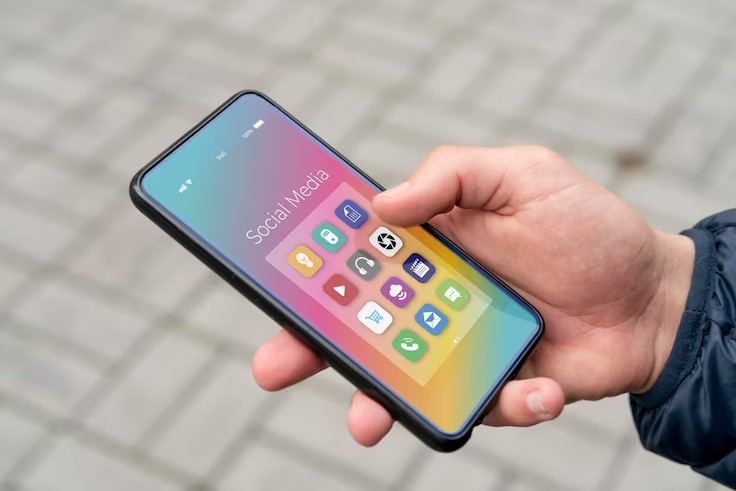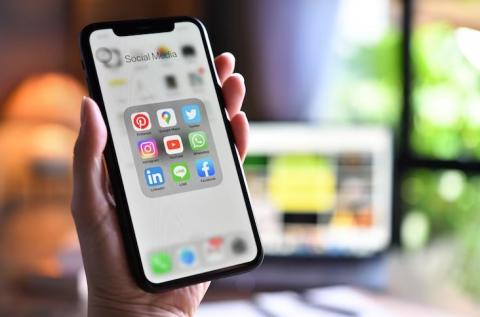
With the increased use of smartphones and tablets, mobile applications have become a popular and convenient way to access online services and content. Advances in mobile technology have allowed applications to be more powerful and efficient, leading to a better user experience and increased demand for mobile applications.
Mobile apps also offer a wide variety of features and benefits, such as personalization, social interaction, geolocation, security, fitness tracking, productivity, and entertainment. All this has led to increased demand and adoption of mobile applications by users.
Currently, there are more than 5.7 million mobile apps between Google Play and the Apple App Store, according to a report shared by Zippia. Likewise, they indicated that the average user uses 9 to 10 mobile applications per day and at least 30 mobile applications per month. And as if that were not enough, 85% of the time that people have their phone in hand is browsing between applications.

If the above figures didn't shock you enough, check this out: Between 2019 and 2020, more than 250 million apps were downloaded daily around the world. Zippia experts estimated that by 2024 this figure could rise to 500 million downloaded mobile apps.
Steps prior to developing a mobile application: What must be done?
Although company leaders want to create a mobile application overnight, the truth is that certain steps must be followed before starting the project. This ensures that the software development cycle is followed correctly and that the project has clear objectives and the right direction based on business goals.
Some of the important steps to follow are:
- Define the purpose of the application
It is important to have a clear idea of what you want to achieve with the application. What problem is it going to solve? What user needs will you satisfy? What is the target audience?
- Carry out a market analysis
It is important to research the existing competition, market trends and user needs to ensure that the application has added value and differentiation in the market.

- Create a project plan
Prepare a plan that contemplates the objectives, the necessary resources, the budget, the calendar and the work team involved in the project.
- Design the user experience (UX)
The user experience is a key aspect for the success of the application. It is important to design an interface that is easy to use, intuitive and attractive to users.
- Develop a prototype
Develop a prototype of the application to test and validate it with users and obtain feedback. This will allow adjustments and improvements to be made before moving forward with full development.
- Choose the platform
Decide if the application will be developed for Android, iOS or both platforms. Each platform has its own design rules and limitations, which can affect application design and development.
- Define architecture
Define the architecture of the application, that is, how the different parts of the application will be structured, what technologies will be used and how they will integrate with each other.

Importance of choosing the platform on which you are going to develop your mobile application
Android is often the operating system of choice for independent mobile app development teams, and an IBM article explains why: “The vast majority, around 70 percent, of smartphones run Android, and the Google Play Store has fewer restrictions than the Apple App Store.”
Although the above represents a facility for those who are starting out in the world of mobile application development, the truth is that mobile applications developed for iOS “have far fewer devices that need support, which simplifies optimization. And user retention is usually higher for iOS apps”, they added in the same article.
When choosing the platform, leaders must consider the intended use of the mobile application, as well as the target audience to which it will be directed. Since, depending on the navigation of the users, a multiplatform mobile application can be created, which provides facilities for both Android and iOS users.
In any case, IBM sees it prudent to start with the development of an Android mobile application as the process is a little easier and, after having the MVP on Android, convert and transform that application to iOS.

What do users expect from your applications?
Mobile users are really demanding: they want an app that immediately responds to their demands and needs. Imagine a healthcare mobile app running slowly or throwing errors. A person's life could depend on this mobile application, so it is essential that it have optimal operation.
“Seventy-nine percent of app users in a Compuware survey reported that they would only give an app one or two more tries if it didn't work on the first try. Only 16 percent said they would give an application more than two tries", they explained in an article in Business Collective magazine.
They also cited the most common performance problems that plague users, such as app crashes, delays in its operation, slow loading, among other aspects.
Some of the main expectations that users have of mobile applications are:
Ease of Use: Users expect mobile apps to be easy to use, with an intuitive interface and simple navigation.
Speed: Users expect mobile applications to be fast to load and respond to their actions.
Personalization: Users expect mobile applications to adapt to their needs and preferences, offering personalization options and the ability to save and access personal information.
Reliability: Users expect mobile apps to be reliable and not crash or close unexpectedly.
Security: Users expect their personal and financial data to be secure in the app and that steps are taken to protect their privacy.
Regular updates: Users expect mobile apps to be updated regularly, offering new functionality and improving the user experience.

Stages of developing a mobile application
1. Define the purpose and functionality of the application
Before starting to develop the application, it is important to define the purpose and the functions that the application should have. It is necessary to carry out market and competition research, and define the needs of the users to whom the application is directed.
2. Design the user interface
The user interface is the face of the application, and it must be carefully designed to be attractive, easy to use and adapt to the needs of the users. Design tools can be used to create prototypes and mockups.
3. Select the platform
Once the objective and functionality of the application have been defined, the development platform must be selected. The two main platforms are Android and iOS. Cross-platform mobile applications can also be developed.
4. Develop the application
In this stage, the application is coded, features are added, and the user interface is integrated. It is important to follow the design guides and development best practices for each platform.
5. Test the app
Once the app is developed, it should be tested on different devices to make sure that it works correctly and without errors. Performance, security and usability tests can be performed.
6. Launch the app
After testing, the app can be released on the appropriate app store. You need to follow the app store's policies and rules, such as maximum app size, privacy requirements, and pricing policies.
7. Maintain and update the application
Once the application is released, it is important to maintain and update it regularly. This may include bug fixes, performance improvements, security updates, and new features.
Developing a mobile app involves defining the purpose and functionality of the app, designing the user interface, selecting the platform, developing the app, testing it, releasing it, and regularly maintaining and updating it. It's important to follow development best practices and app store policies to be successful in the mobile app marketplace.
Do you need to develop a mobile application? At Rootstack, we have +10 years of experience supporting companies in their digital transformation. Contact us!
We recommend this video

